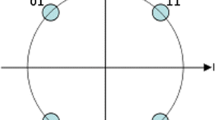Abstract
This paper proposes a full-rate space-time code selection technique for multiple transmitter antenna diversity systems. The technique uses orthogonal space-time codes for transmitting with two antennas and a quasi-orthogonal space-time code when transmitting with four antennas. We selected the space-time code and the transmitter antennas by comparing the equivalent SISO channels with a set of predetermined threshold levels, found off-line as a function of the Doppler frequency. The performance of the proposed technique was evaluated using the error rate and the spectral efficiency, outperforming other existing techniques.













Similar content being viewed by others
References
Cheng X, Zhang R, Yang L (2018) Wireless toward the era of intelligent vehicles. IEEE Internet Things J. 6:188–202
Zhang P, Yang X, Chen J, Huang Y (2019) A survey of testing for 5g: Solutions, opportunities, and challenges. China Commun 16:69–85
Gourdin E, Medhi D, Pattavina A (2018) Design of reliable communication networks. AoT 73(1):1–3. https://doi.org/10.1007/s12243-017-0624-1
Sternad M, Svensson T, Ottosson T, Ahlen A, Svensson A, Brunstrom A (2007) Towards systems beyond 3G based on adaptive OFDMA transmission. Proc IEEE 95(12):2432–2455. https://doi.org/10.1109/JPROC.2007.907119
Drajic DB, Ivanis PN (2013) Link adaptation as a technique to achieve information-theoretic limits in MIMO systems?. In: Telecommunication in Modern Satellite, Cable and Broadcasting Services (TELSIKS), 2013 11th International Conference on, vol 01, pp 209–216
Bedeer E, Dobre OA, Ahmed MH, Baddour KE (2014) A multiobjective optimization approach for optimal link adaptation of OFDM-based cognitive radio systems with imperfect spectrum sensing. Wireless Communications, IEEE Transactions on 13(4):2339–2351. https://doi.org/10.1109/TWC.2014.022114.131948
Dong Z, Fan P, Panayirci E, Lei X (2014) Conditional power and rate adaptation for MQAM/OFDM systems under CFO with perfect and imperfect channel estimation errors. Vehicular Technology, IEEE Transactions on PP(99):1–1. https://doi.org/10.1109/TVT.2014.2377153
Alamouti S (1998) A simple transmit diversity technique for wireless communications. JSAC 16 (8):1451–1458
Tarokh V, Jafarkhani H, Calderbank AR (1999) Space-time block coding for wireless communications: performance results. JSAC 17:451–460
Molisch AF, Win MZ, Winters JH (2003) Reduced-complexity transmit/receive diversity systems. TSP 51(11):2729–2738
Thoen S, der Perre LV, Gyselinckx B, Engels M (2001) Performance analysis of combined transmit-SC/receive-MRC. TOC 49:5–8
Chen Z, Yuan J, Vucetic B (2005) Analysis of transmit antenna selection/maximal-ratio combining in Rayleigh fading channels. vtc 54(4):1312–1321
Mavares D, Torres RP (January 2008) Space-time code selection for transmit antenna diversity systems. vtc 57(1):620–629
Ahmadi A, Talebi S, Shahabinejad M (2015) A new approach to fast decode quasi-orthogonal space-time block codes. IEEE Trans Wirel Commun 14(1):165–176
Martins CAR, Brandão ML, Brandani da Silva E (2019) New space-time block codes from spectral norm. PLOS ONE 14(9):1–35. https://doi.org/10.1371/journal.pone.0222708
Mavares D, Torres RP (February 2009) Space-time code selection for OFDM-MISO systems. ComCom 32(3):477–481
Mavares D, Torres RP, Uzcátegui RA (2011) Constant-rate adaptive space-time code selection technique for wireless communications. In: The Sixth International Conference on Digital Telecommunications (ICDT 2011)
Mavares D, Velasquez R, Candotti K, Huerta M (2015) Space-time code selection using channel prediction. 2015 Asia-Pacific Conference on Computer Aided System Engineering, pp 63–67
Terán DM, Oropeza M, Velásquez RJB (2020) Space-time code selection via particle swarm optimization. Ann Telecommun 75:59–66
Tarokh V, Jafarkhani H, Calderbank AR (1999) Space-time block codes from orthogonal designs. IEEE Trans Inf Theory 45(5):1456–1467. https://doi.org/10.1109/18.771146
Tarokh V, Seshadri N, Calderbank AR (1998) Space-time codes for high data rate wireless communication: performance criterion and code construction. TIT 44(2):744–765
Jafarkhani H (2010) Space-time coding: theory and practice, 1st edn. Cambridge University Press, New York, NY, USA
Xian L, Liu H (2005) Rate-one space-time block codes with full diversity. IEEE Trans Commun 53(12):1986–1990. https://doi.org/10.1109/TCOMM.2005.860081
Azzam L, Ayanoglu E (2008) Maximum likelihood detection of quasi-orthogonal space-time block codes: analysis and simplification. In: 2008 IEEE International Conference on Communications, pp 3948–3954
Azzam L, Ayanoglu E (2008) Reduction of ml decoding complexity for mimo sphere decoding, qostbc, and ostbc. 2008 Information Theory and Applications Workshop, pp 18–25
Jakes WC (1971) A comparison of specific space diversity techniques for reduction of fast fading in uhf mobile radio systems. IEEE Trans Veh Technol 20(4):81–92. https://doi.org/10.1109/T-VT.1971.23485
T. DM, Torres RP (December 2004) Overcomplete channel estimation for OSTBC-OFDM based systems. In: International Conference on Telecommunications and Network Computers (IADAT-tcn2004), IADAT, San Sebastián, Spain
Mavares D (2019) Constant-rate space-time code selection design using particle swarm optimization. In: The XXII Symposium on Image, Signal Processing and Artificial Vision, STSIVA 2019
Shin H, Lee JH (2002) Exact symbol error probability of orthogonal space-time block codes. In: GLOBECOM 2002 - IEEE Global Telecommunications Conference, vol 21, pp 1206–1210
Nicolet FL, Gander W, Harms J, Läuchli P, Vogel J, Zehnder CA (1980) Informatik für ingenieure. Springer, Berlin Heidelberg
Semmar A, Ha PV, Chouinard J-Y, Lafléche S, Wang X, Wu Y (2004) Uhf wideband mobile channel measurements and characterization using atsc signals with diversity antennas
Author information
Authors and Affiliations
Corresponding author
Additional information
Publisher’s note
Springer Nature remains neutral with regard to jurisdictional claims in published maps and institutional affiliations.
Rights and permissions
About this article
Cite this article
Mavares T., D., Diaz España, K.M. & Ochoa Escobar, L.I. Full data rate space-time code selection. Ann. Telecommun. 77, 677–688 (2022). https://doi.org/10.1007/s12243-021-00900-9
Received:
Accepted:
Published:
Issue Date:
DOI: https://doi.org/10.1007/s12243-021-00900-9




